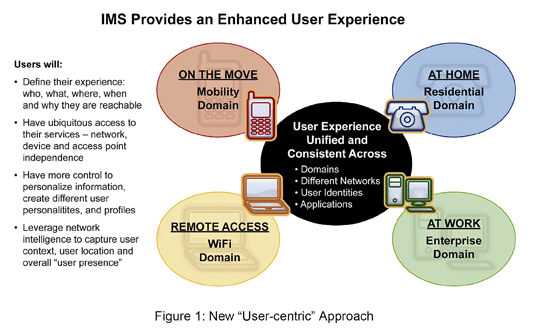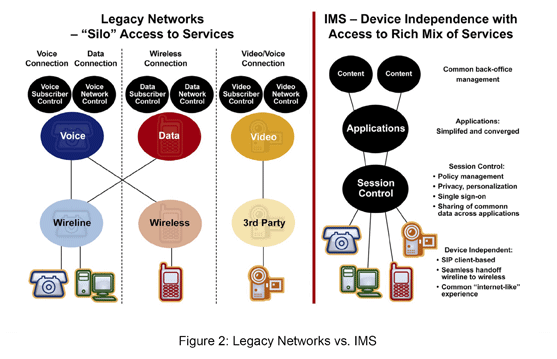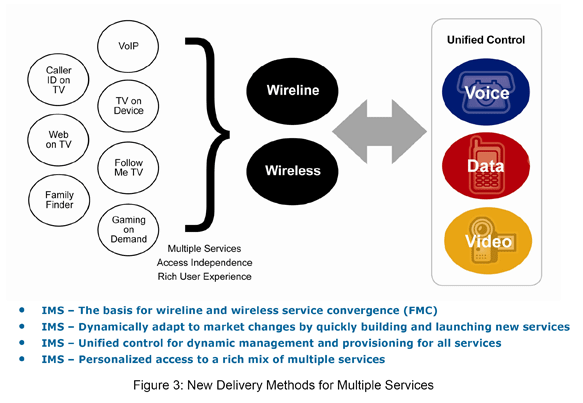Some times the best way to start the new year is to look back. For those readers who are just now getting acquainted with IMS or are in need of a refresher, this article should serve your needs nicely.
The IP Multimedia Subsystem (News - Alert) (IMS) architecture was defined by the 3rd Generation Partnership Project (3GPP), which evolved from third-generation (3G) mobile communication system standardization work for W-CDMA. IMS is an infrastructure for multimedia services such as video, telephony, multimedia messaging and games – for one-to-one or one-to-many multimedia communications. The architecture has been adopted by 3GPP2 for cdma2000 wireless networks and for fixed networks (TISPAN).
IMS, a new layer inserted into networks as they migrate to 3G, makes voice calls and data calls all look the same. What has traditionally been separate traffic over separate networks – push-to-talk (PTT), voice, multimedia messaging system (MMS), e-mail, etc. – will merge together so that all calls are treated as IP-based traffic across a data network. An IP-based session can start with a VoIP call and transform into the delivery of a picture, live video or data, and then back into voice. With IMS, the content of a conversation doesn’t matter since everything is treated as IP-based data packets. The lines between mobile and fixed broadband access become indistinguishable, and so does the distinction between a handset and a PC. By using IMS, devices can place a phone call or send video to a PC just as easily as to another phone.
When data networks become all IP, it doesn’t matter whether data originates or terminates on a broadband PC, a mobile phone, a system in a vehicle, an appliance, or any other type of device. What does matter is that both end-devices have client applications speaking the same language, such as SIP, MP3, MPEG, etc. Users will be able to transfer their phone calls between mobile and fixed phone lines. And they’ll be able to access their data services whether at home or on-the-go, enabling a truly “nomadic” communications experience.
As a part of IMS, fixed-mobile convergence (FMC) is emerging as one of the most critical elements in delivering a full range of anytime, anywhere services over any and all available network resources and connections. FMC provides a seamless environment spanning mobile phones and devices, land lines and other connections.
As illustrated in Figure 1, IMS enables a user-centric approach to service delivery.
 |
IMS migrates the network from vertical integration – “silos” – to a horizontal construction where general functions can be reused for multiple applications (See Figure 2).
 |
This horizontal architecture specifies bearer control, charging, interoperability, roaming and security. IMS provides for a number of communal generic functions that can be reused by virtually all services in the network. Examples of these communal functions are group/list management, provisioning, operation administration and management (OA&M), charging and deployment. The reuse of common infrastructure also minimizes operating expenses and capital expenses for operators, especially in areas associated with service provisioning, OA&M, customer care and billing.
The IMS Architecture: Three Layers
How is this accomplished? In order to support the full range of functionality listed above and to achieve ubiquitous communications, the IMS architecture is split into three layers: session, application and connectivity (See Figure 4).
 |
The session control layer is made up of network control servers for managing calls, establishing sessions and making modifications. There are two main elements of this layer: the call session control function (CSCF) and the home subscriber server (HSS). The CSCF handles end-point registration and routing the SIP signaling messages to the application server related to a particular service. The CSCF is also responsible for interoperating with the access and transport layers to guarantee quality of service (QoS) for all services. Each end user’s service profile is maintained by the HSS database for authentication and authorization purposes. Stored on a central server, this profile could include such data as registration information (IP address), roaming and voice mailbox preferences.
The application server layer provides value-added services using application and content servers. The fundamental building blocks of this layer are the application server (AS) and the media resource function (MRF), with its media resource function controller (MRFC) and media resource function processor (MRFP) sub-elements. The AS is responsible for call flows, database accesses and subscribers’ user interface interactions. The MRF provides accessory media processing for the application layer. It is a source of media in the home network and plays announcements, mixes media streams and transcodes between different voice codecs. MRFC acts as an SIP user agent to the S-CSCF, and it controls the MFRP with an H.248 (Megaco) interface. MRFC is a signaling plane node. MRFP implements all media-related functions and is a media plane node.
The connectivity layer is made up of routers and switches for the access networks and for the backbone. For example, the connectivity layer could comprise a fixed IP backbone network or a mobile network such as GSM or GPRS.
Functionality Enabled by IMS
• Access independence: IMS architecture will work with any packet-switching network, whether fixed, mobile or wireless, such as CDMA2000, xDSL, GPRS, UMTS, WiMAX, WLAN, etc. Gateways provide access to the IP-based infrastructure by performing packetization for older phone systems. Just like the current subscriber model for mobile phones, users directly register with an IMS network (even when roaming in another country or network). The open interfaces between control layer and service layer allows mixing calls/sessions from different access networks.
• Network architecture independence: IMS allows operators and service providers to use different underlying network architectures. This reduces the cost of deployment by removing the requirement to invest in entirely new equipment.
• Mobility: The mobile network provides terminal mobility (roaming), while IMS and SIP provide user access.
• IP-based services: IMS makes it easier to offer any IP-based service. This enables service providers to add differentiating, revenue-generating features and services for their end customers. Examples include those listed in Table 1.
IMS enables service providers to quickly develop, deploy and manage new revenue-generating applications and services (See Figure 3).
 |
To end users, all of these new services appear to be highly customized to their personal preferences. Some examples of these advanced applications are:
• Converged voice
- Wireline – wireless
- WiFi (News - Alert) – cellular integration
• Wireless transport
- An all IP transport evolution
- Ability to deliver on cost and scalability requirements
• IPTV/IP multimedia, streaming media
- Triple Play (News - Alert) – scalable, voice, video and data services
• Converged Ethernet transport
- End-to-end carrier Ethernet transport solution for Triple Play and VPN
• Network-based enterprise and consumer VoIP
- IMS-enabled business productivity and personal applications
Conclusion
In summary, the benefits of 3GPP/3GPP2/ETSI NGN IMS solutions for end users and service providers go beyond PTT telephony. End users will enjoy a rich service environment, mixed multimedia sessions, presence management and simplified, seamless access to the entire portfolio of services. Service providers gain integrated service offerings, interoperability and interworking, fast time-to-revenue, standardization (which equates to streamlined applications), open interfaces, reduced capital, and reduced operating expenses in the context of new approaches to the “value chain.”

John Perry is the Director of Marketing at Centillium (News - Alert) Communications. For more information, visit the company online at www.centillium.com.
|

